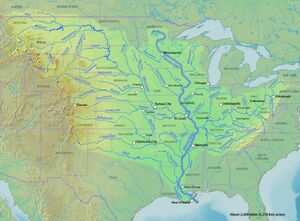
Mississippi River near Harpers Ferry, Iowa
The Mississippi River was the chief river of the large drainage system on the North American continent. Flowing entirely in the United States (though its drainage basin reaches into Canada), it rises in northern Minnesota and meanders slowly southwards for 2,320 miles (3,730 km) to the Mississippi River Delta at the Gulf of Mexico. With its many tributaries, the Mississippi's watershed drains all or parts of 31 U.S. states and 2 Canadian provinces between the Rocky and Appalachian Mountains. The Mississippi ranks as the fourth longest and tenth largest river in the world. The river either borders or passes through the states of Minnesota, Wisconsin, Iowa, Illinois, Missouri, Kentucky, Tennessee, Arkansas, Mississippi, and Louisiana.
Native Americans long lived along the Mississippi River and its tributaries. Most were hunter-gatherers or herders, but some, such as the Mound builders, formed prolific agricultural societies. The arrival of Europeans in the 1500s changed the native way of life as first explorers, then settlers, ventured into the basin in increasing numbers. The river served first as a barrier – forming borders for New Spain, New France, and the early United States – then as a vital transportation artery and communications link. In the 19th century, during the height of Manifest Destiny, the Mississippi and several western tributaries, most notably the Missouri, formed pathways for the western expansion of the United States.

Predark map of Mississippi River tributary structure
Formed from thick layers of this river's silt deposits, the Mississippi River Valley was one of the most fertile agricultural regions of the country, which resulted in the river's storied steamboat era. During the American Civil War, the Mississippi's capture by Union forces marked a turning point towards victory because of the river's importance as a route of trade and travel, not least to the Confederacy. Because of substantial growth of cities and the larger ships and barges that supplanted riverboats, the decades following the 1900s saw the construction of massive engineering works such as levees, locks and dams, often built in combination.
Deathlands[]
In many places the Mississippi River has changed course, wiping out entire towns and changing the shape of the land forever.
Stickies colonies of had been established around the confluence of the Yazoo and the Sippi for fifty years prior to the events of Iron Rage.